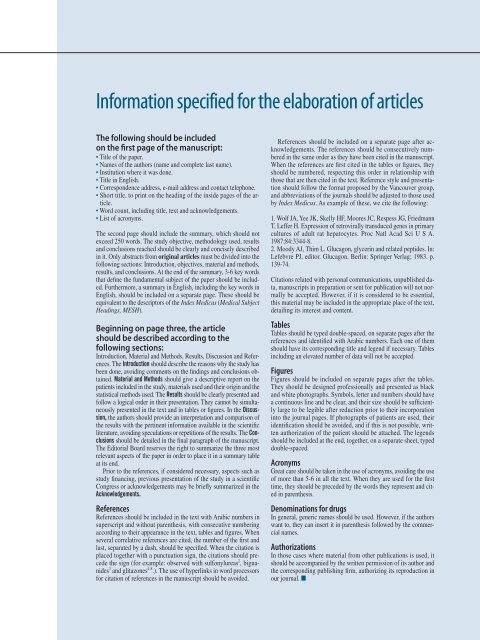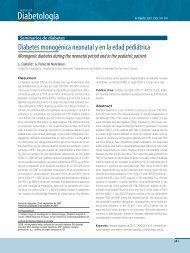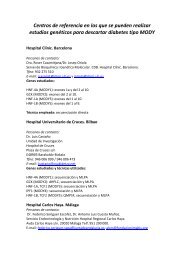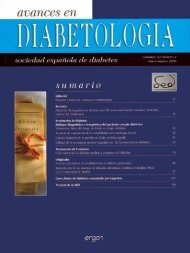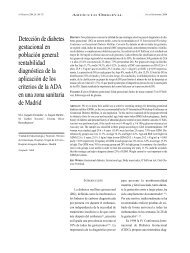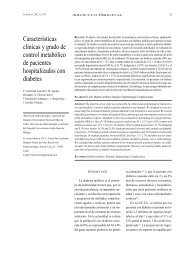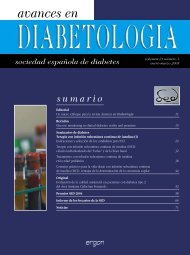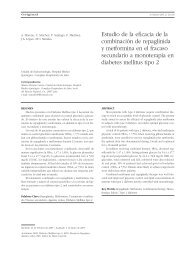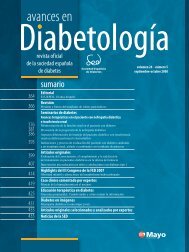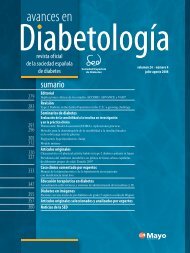00A PORT Y LOMO AVA.indd - Sociedad Española de Diabetes
00A PORT Y LOMO AVA.indd - Sociedad Española de Diabetes
00A PORT Y LOMO AVA.indd - Sociedad Española de Diabetes
Create successful ePaper yourself
Turn your PDF publications into a flip-book with our unique Google optimized e-Paper software.
Information specified for the elaboration of articles<br />
The following should be inclu<strong>de</strong>d<br />
on the first page of the manuscript:<br />
• Title of the paper.<br />
• Names of the authors (name and complete last name).<br />
• Institution where it was done.<br />
• Title in English.<br />
• Correspon<strong>de</strong>nce address, e-mail address and contact telephone.<br />
• Short title, to print on the heading of the insi<strong>de</strong> pages of the article.<br />
• Word count, including title, text and acknowledgements.<br />
• List of acronyms.<br />
The second page should inclu<strong>de</strong> the summary, which should not<br />
exceed 250 words. The study objective, methodology used, results<br />
and conclusions reached should be clearly and concisely <strong>de</strong>scribed<br />
in it. Only abstracts from original articles must be divi<strong>de</strong>d into the<br />
following sections: Introduction, objectives, material and methods,<br />
results, and conclusions. At the end of the summary, 3-6 key words<br />
that <strong>de</strong>fine the fundamental subject of the paper should be inclu<strong>de</strong>d.<br />
Furthermore, a summary in English, including the key words in<br />
English, should be inclu<strong>de</strong>d on a separate page. These should be<br />
equivalent to the <strong>de</strong>scriptors of the In<strong>de</strong>x Medicus (Medical Subject<br />
Headings, MESH).<br />
Beginning on page three, the article<br />
should be <strong>de</strong>scribed according to the<br />
following sections:<br />
Introduction, Material and Methods, Results, Discussion and References.<br />
The Introduction should <strong>de</strong>scribe the reasons why the study has<br />
been done, avoiding comments on the findings and conclusions obtained.<br />
Material and Methods should give a <strong>de</strong>scriptive report on the<br />
patients inclu<strong>de</strong>d in the study, materials used and their origin and the<br />
statistical methods used. The Results should be clearly presented and<br />
follow a logical or<strong>de</strong>r in their presentation. They cannot be simultaneously<br />
presented in the text and in tables or figures. In the Discussion,<br />
the authors should provi<strong>de</strong> an interpretation and comparison of<br />
the results with the pertinent information available in the scientific<br />
literature, avoiding speculations or repetitions of the results. The Conclusions<br />
should be <strong>de</strong>tailed in the final paragraph of the manuscript.<br />
The Editorial Board reserves the right to summarize the three most<br />
relevant aspects of the paper in or<strong>de</strong>r to place it in a summary table<br />
at its end.<br />
Prior to the references, if consi<strong>de</strong>red necessary, aspects such as<br />
study financing, previous presentation of the study in a scientific<br />
Congress or acknowledgements may be briefly summarized in the<br />
Acknowledgements.<br />
References<br />
References should be inclu<strong>de</strong>d in the text with Arabic numbers in<br />
superscript and without parenthesis, with consecutive numbering<br />
according to their appearance in the text, tables and figures. When<br />
several correlative references are cited, the number of the first and<br />
last, separated by a dash, should be specified. When the citation is<br />
placed together with a punctuation sign, the citations should prece<strong>de</strong><br />
the sign (for example: observed with sulfonylureas 2 , biguani<strong>de</strong>s<br />
3 and glitazones 4-8 .). The use of hyperlinks in word processors<br />
for citation of references in the manuscript should be avoi<strong>de</strong>d.<br />
References should be inclu<strong>de</strong>d on a separate page after acknowledgements.<br />
The references should be consecutively numbered<br />
in the same or<strong>de</strong>r as they have been cited in the manuscript.<br />
When the references are first cited in the tables or figures, they<br />
should be numbered, respecting this or<strong>de</strong>r in relationship with<br />
those that are then cited in the text. Reference style and presentation<br />
should follow the format proposed by the Vancouver group,<br />
and abbreviations of the journals should be adjusted to those used<br />
by In<strong>de</strong>x Medicus. As example of these, we cite the following:<br />
1. Wolf JA, Yee JK, Skelly HF, Moores JC, Respess JG, Friedmann<br />
T, Leffer H. Expression of retrovirally transduced genes in primary<br />
cultures of adult rat hepatocytes. Proc Natl Acad Sci U S A.<br />
1987;84:3344-8.<br />
2. Moody AJ, Thim L. Glucagon, glycerin and related pepti<strong>de</strong>s. In:<br />
Lefebvre PJ, editor. Glucagon. Berlin: Springer Verlag; 1983. p.<br />
139-74.<br />
Citations related with personal communications, unpublished data,<br />
manuscripts in preparation or sent for publication will not normally<br />
be accepted. However, if it is consi<strong>de</strong>red to be essential,<br />
this material may be inclu<strong>de</strong>d in the appropriate place of the text,<br />
<strong>de</strong>tailing its interest and content.<br />
Tables<br />
Tables should be typed double-spaced, on separate pages after the<br />
references and i<strong>de</strong>ntified with Arabic numbers. Each one of them<br />
should have its corresponding title and legend if necessary. Tables<br />
including an elevated number of data will not be accepted.<br />
Figures<br />
Figures should be inclu<strong>de</strong>d on separate pages after the tables.<br />
They should be <strong>de</strong>signed professionally and presented as black<br />
and white photographs. Symbols, letter and numbers should have<br />
a continuous line and be clear, and their size should be sufficiently<br />
large to be legible after reduction prior to their incorporation<br />
into the journal pages. If photographs of patients are used, their<br />
i<strong>de</strong>ntification should be avoi<strong>de</strong>d, and if this is not possible, written<br />
authorization of the patient should be attached. The legends<br />
should be inclu<strong>de</strong>d at the end, together, on a separate sheet, typed<br />
double-spaced.<br />
Acronyms<br />
Great care should be taken in the use of acronyms, avoiding the use<br />
of more than 5-6 in all the text. When they are used for the first<br />
time, they should be prece<strong>de</strong>d by the words they represent and cited<br />
in parenthesis.<br />
Denominations for drugs<br />
In general, generic names should be used. However, if the authors<br />
want to, they can insert it in parenthesis followed by the commercial<br />
names.<br />
Authorizations<br />
In those cases where material from other publications is used, it<br />
should be accompanied by the written permission of its author and<br />
the corresponding publishing firm, authorizing its reproduction in<br />
our journal. ■


